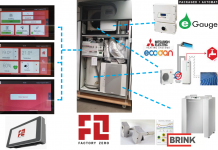When incandescent light bulbs are phased out in the United States between 2012 to 2014, managers of utility Demand Side Management (DSM) programs will be between a rock and a hard place. At the Southwest Energy Efficiency Project‘s 5th annual Energy Efficiency Workshop, this fact seemed to be the elephant in the room that most of the utility executives in attendance did not want to talk about.
One Trick Pony
It’s not for nothing that the compact fluorescent bulb, or CFL, has become the international symbol of energy efficiency. While it is true that we’re not going to stop global warming by changing light bulbs, switching out an incandescent for a CFL is one of the most cost effective and simplest steps we can take along the way. CFLs are so cost effective that current DSM programs get the bulk of their electricity savings from this single measure.
In 2007, Efficiency Vermont saved over 1.7%[pdf] of the state’s electric load while the vast majority of DSM programs save only a fraction of 1%. 78% of these savings came from lighting, meaning that the program’s outstanding performance is almost entirely attributable to CFLs.
Larry Holmes, the manager of NV Energy/ Sierra Pacific Resources‘s (NYSE:SRP) DSM program told me that his programs get about half their electricity savings from CFLs, and that, the company’s other DSM programs will not be able to ramp up to replace the savings from CFLs.
These programs are not alone… CFLs are a staple of DSM programs everywhere, so it makes sense for utilities and environmental advocates alike to promote the use of this simple, cost effective measure.
What’s Next?
Although it will make the job of DSM programs harder, for a societal perspective, the phase out of incandescent bulbs will be a good thing: more people will use energy efficient lights, and they will no longer need to be bribed with bulb buy-downs and giveaways to do something which is already in their best interest, such as saving money by using CFLs.
The problem comes because regulators have mandated fixed amounts of savings for years into the future, and these savings are measured in comparison to a benchmark of what customers would otherwise be doing. In the case of lighting, when CFLs or other energy efficient options become the legal default, DSM programs will only be able to achieve savings by encouraging even more efficient options.
A program manager for residential programs at CEE, the industry association of efficiency programs, told me that she has hopes for solid state lighting, a.k.a. light emitting diodes or LEDs. I’m intentionally omitting her name from this article because a quick examination of that idea shows that it is mathematically impossible. The fact that industry insiders hold out these hopes for LEDs shows that the industry has little idea of how to replace the CFL in residential DSM.
To see why LEDs in 2014 will not produce similar savings to CFLs today, consider the following example. Replacing a 100 watt which is incandescent used for 1000 hours a year with a 25 watt CFL will save 75 kWh a year. In contrast, replacing a 25w CFL with an 10 watt LED bulb only saves 15 kWh a year, or 1/5 as much. Currently an LED bulb powerful enough to replace a 25w CFL or 100w incandescent uses 13 watts (and costs $80), so even these savings assume considerable improvements in LED prices and efficiency. Note that further technology improvement does not solve the core problem.
Even if we assume that there will be a lighting solution which uses no energy, the potential savings from residential lighting will drop by a factor of three when CFLs become standard, because only 25 watts can now be saved by any technology, where before the savings potential was 100 watts. Hence, the savings potential in residential lighting will drop by a factor of at least four between 2012 and 2014, meaning that most of the savings currently achievable in residential lighting will have to be made up by other programs.
The Investment Angle
For electric utility investors, this is important because utility regulators usually grant incentives to utilities which meet or exceed their DSM targets. For large DSM programs, these incentives can have a significant impact on earnings, and this impact will only grow as utilities meet more of their resource needs with DSM. Yet, because of the loss of one very important measure in DSM programs, many utilities are likely to miss their savings targets during the 2012 to 2015 time period, unless regulators decide to ease the targets. Investors who are buying utilities now as a safe haven during a recession may want to sell these stocks before the utilities start to miss their DSM targets.
As utilities ramp up other programs in an effort to replace the CFL, other household energy efficiency measures will benefit. Those measures likely to benefit the most will address the projected large uses of residential electricity. Measures which address heating and cooling efficiency, such as efficient air conditioners and heat pumps, as well as low cost measures such as duct sealing and air conditioning tune ups. Companies which can figure out ways to inexpensively tune up air conditioners, or seal household ducts will be in an excellent position.
Another large (and growing) user of residential electricity which DSM programs are just beginning to address is household electronics, especially televisions and set-top boxes, both when in use and in "off" mode. Finally, even though LEDs will not be able to replace more than a fraction of the savings from CFLs, they will be part of the mix, especially in high usage lighting.
DISCLOSURE: Tom Konrad does not own any of the securities mentioned.
DISCLAIMER: The information and trades provided here are for informational purposes only and are not a solicitation to buy or sell any of these securities. Investing involves substantial risk and you should evaluate your own risk levels before you make any investment. Past results are not an indication of future performance. Please take the time to read the full disclaimer here.









The presentation of the efficiency of LEDs is all wrong. While CFLs provide a 75% savings over incandecents, LEDs provide a 87% savings over incandecents. Likewise, as efficient as CFLs are, LEDS use about half as much electricity as CFLs, and therefore provide a 48% savings OVER CFLs. With the disposal / mercury problems, as well as dependability issues of CFLs, the regs should skip the CFLs and jump right to LEDs.
MB-
Since DSM progams must acheive absolute as opposed to relative, or percentage, savings, there is no contraditction between what you and I are saying. DSM programs must acheive absolute savings to acheive their goals.
The calculation I presented assumed that LEDs provide a 90% savings over incandescents, which is more than the number you quote. Current LEDs are closer to your number, but I am allowing for technology improvement over the next few years.
“The problem comes because regulators have mandated fixed amounts of savings for years into the future”
This is not a problem…it is by design. Did you note that lighting is already a low percentage of total energy usage compared thermal management? That is (and always has been) where the major savings will come. A little push is clearly needed to find additional solutions that are win-win like CFLs. They are out there.
Your post seems arbitrarily negative, based on the fact that CFLs are a home-run in terms of efficiency. Does an actual home-run reduce the total number of future home-runs? or does it spur better training and lead to more home-runs?
It’s a matter of perspective. I, personally, think that difficult goals for DSM programs are a good thing, but it is a “problem” from the perspective of program managers… and it may be a problem for us all if the goals are unt acheivable.
There are no lack of ways to save significant amounts of energy, as you point out, but it is often quite expensive to get these technologies into the houses of consumers who could not care less about energy.